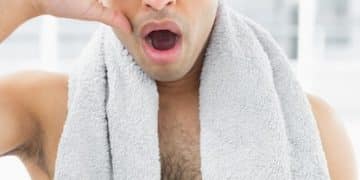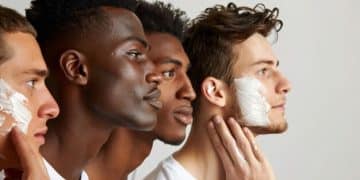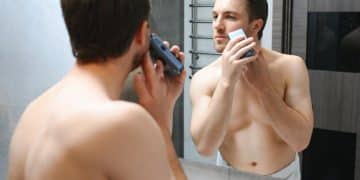Post-Workout Skincare: Prevent Breakouts & Maintain Clear Skin
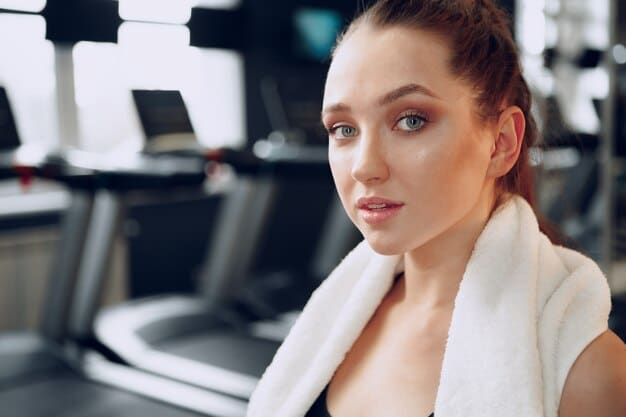
Achieving clear skin after a workout demands a strategic approach to skincare, focusing on immediate cleansing, proper hydration, and targeted treatments to counteract sweat, bacteria, and inflammation that often lead to post-gym breakouts.
Stepping out of the gym refreshed shouldn’t lead to skin dilemmas. Many active individuals face the frustrating challenge of breakouts after a strenuous workout, an unwelcome side effect of sweat, friction, and environmental factors. This comprehensive guide delves into effective strategies for Post-Workout Skincare: 4 Steps to Prevent Breakouts After the Gym, ensuring your skin remains as healthy and clear as your body feels.
Understanding the Post-Workout Skin Challenge
Our skin undergoes a significant transformation during and after physical exercise. The increased blood circulation brings a healthy glow, but it also elevates body temperature, leading to perspiration. While sweating is a natural and essential bodily function for cooling down, it also creates an ideal environment for bacteria to thrive on the skin’s surface, particularly when mixed with sebum, dirt, and dead skin cells.
The combination of sweat, oil, and external irritants can clog pores, leading to the formation of pimples, blackheads, and whiteheads. Furthermore, friction from workout gear, such as headbands, caps, or tight clothing, can exacerbate the problem, causing what is commonly known as “acne mechanica.” Understanding these underlying mechanisms is the first step toward implementing an effective preventative skincare regimen.
The Science Behind Sweat and Skin
Sweat, or perspiration, is primarily composed of water, but it also contains small amounts of salts, urea, and other metabolic byproducts. When sweat evaporates from the skin, it leaves behind these residues, along with any existing bacteria. These lingering compounds act as a rich nutrient source for the bacteria on your skin, leading to their proliferation. The presence of excess bacteria, combined with clogged pores, creates the perfect storm for inflammatory responses that manifest as acne.
- Sebum Production: Exercise can stimulate oil glands, leading to an increase in sebum, which can mix with sweat and dead skin cells to block pores.
- Bacterial Growth: The warm, moist environment on the skin’s surface post-workout is ideal for acne-causing bacteria like Propionibacterium acnes (P. acnes).
- Friction and Irritation: Tight clothing, helmets, or even towels vigorously rubbing against the skin can cause micro-abrasions, pushing bacteria deeper into pores and triggering inflammation.
Beyond acne, some individuals might experience other skin irritations, such as folliculitis (inflammation of hair follicles), heat rash, or even fungal infections, if proper post-workout hygiene is neglected. Recognizing the specific triggers for your skin type is crucial for tailoring a personalized and effective skincare routine.
The quality of your workout clothes can also play a significant role. Fabrics that don’t breathe well or trap moisture can worsen the situation. Opting for moisture-wicking materials can help manage perspiration more effectively, minimizing its contact time with the skin.
Common Post-Workout Skin Issues
Identifying the specific skin issues you face after the gym is key to addressing them. While breakouts are common, their manifestation can vary. Some might experience only a few scattered pimples, while others grapple with cystic acne, particularly on the back, chest, or hairline. Recognizing these patterns helps you target the problem areas with appropriate products and practices.
Factors like diet, stress, and hormonal fluctuations can also influence skin health and how it reacts to post-workout conditions. A holistic approach that considers internal and external factors will yield the best results for maintaining clear and healthy skin.
Step 1: Immediate Cleansing – The First Line of Defense
The cardinal rule of post-workout skincare is prompt cleansing. The sooner you remove sweat, oil, and bacteria from your skin, the less likely they are to cause problems. This step is not just about feeling clean; it’s about actively preventing pore congestion and bacterial proliferation.
Ideally, you should cleanse your face and body within minutes of finishing your workout. If a full shower isn’t immediately possible, using cleansing wipes can be a temporary solution, but a thorough wash should follow as soon as you get home. It’s important to remember that not all cleansers are created equal, and choosing the right one for your skin type is paramount.
Choosing the Right Cleanser
For acne-prone skin, look for cleansers containing active ingredients known for their pore-clearing and antibacterial properties. Salicylic acid (BHA) is an excellent choice as it’s oil-soluble, allowing it to penetrate deep into pores and dissolve sebum and dead skin cells. Benzoyl peroxide is another effective ingredient, particularly for targeting acne-causing bacteria.
- Salicylic Acid: Ideal for oily and acne-prone skin, it exfoliates inside the pores, preventing blockages.
- Benzoyl Peroxide: Kills acne-causing bacteria and helps shed dead skin cells. Use with caution as it can sometimes be drying or irritating.
- Gentle, pH-balanced Cleansers: For sensitive skin, opt for a mild, non-comedogenic cleanser that won’t strip natural oils or disrupt the skin’s barrier.
When washing, use lukewarm water, as hot water can strip the skin of its natural oils and exacerbate dryness, potentially leading to increased oil production in response. Gently massage the cleanser into your skin for at least 60 seconds to allow the active ingredients to work, then rinse thoroughly. Avoid harsh scrubbing, which can irritate the skin and spread bacteria.
For your body, especially areas prone to breakouts like the back and chest, consider using a body wash formulated with similar acne-fighting ingredients. Pay particular attention to areas where clothing friction is common, such as around the bra straps or waistband.
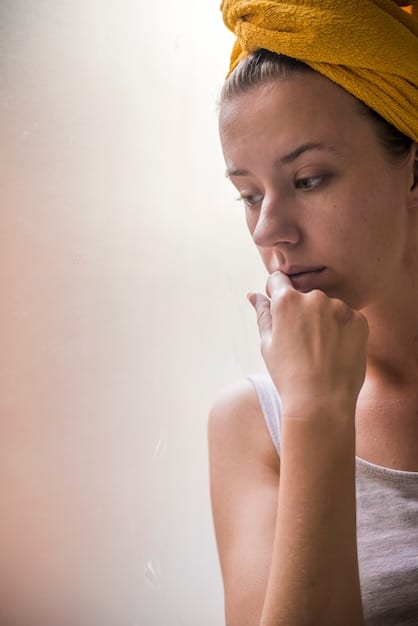
The Importance of Post-Workout Showering
A full shower immediately after your workout is the most effective way to eliminate sweat, bacteria, and grime. Ensure you use a clean towel and pat your skin dry gently, rather than rubbing vigorously. Rubbing can cause irritation and spread bacteria, potentially worsening breakouts.
If you have long hair, consider tying it up during your workout to keep it off your face and neck. Hair products can often transfer to the skin, contributing to breakouts. Showering immediately after will also help remove any sweat and product residue from your hair, preventing them from trickling down onto your clean skin later.
Step 2: Hydration and Toning – Balancing the Skin
Post-cleansing, your skin needs moisture. It’s a common misconception that oily or acne-prone skin doesn’t need hydration. In fact, depriving your skin of moisture can backfire, prompting it to produce even more oil to compensate, potentially leading to more breakouts. Proper hydration helps maintain the skin’s barrier function, keeping it healthy and resilient.
Toning is an optional but often beneficial step. Toners can help rebalance the skin’s pH after cleansing, remove any lingering impurities, and deliver active ingredients. However, avoid toners with high alcohol content, as these can be overly drying and irritating, disrupting the skin’s delicate balance.
Selecting the Right Moisturizer
Look for a lightweight, non-comedogenic moisturizer. “Non-comedogenic” means it won’t clog pores. Gel-based or oil-free formulations are often ideal for oily and acne-prone skin, as they provide hydration without adding excess grease.
- Hyaluronic Acid: A powerful humectant that draws moisture into the skin without feeling heavy.
- Niacinamide (Vitamin B3): Helps reduce inflammation, calm redness, and improve skin barrier function.
- Ceramides: Essential lipids that support the skin’s natural barrier, preventing moisture loss and protecting against irritants.
Even if you have oily skin, your skin can still experience dehydration, especially after sweating a lot. Dehydrated skin can look dull, feel tight, and even lead to increased breakouts. A good moisturizer replenishes the skin’s water content, keeping it supple and comfortable.
Apply moisturizer while your skin is still slightly damp after cleansing. This helps to lock in moisture more effectively. Don’t forget to moisturize your body as well, especially if you used a drying body wash or have dry patches.
Incorporating a Hydrating Toner (Optional)
If you choose to use a toner, opt for one that is hydrating and soothing. Ingredients like rose water, green tea extract, or witch hazel (alcohol-free) can provide additional benefits without stripping the skin.
Toners can also function as a quick refresh if you can’t shower immediately after your workout. A quick spritz of a hydrating mist or a swipe of a gentle toner can help cool down your skin and remove residual stickiness before you can perform a full cleanse.
Step 3: Targeted Treatments – Addressing Specific Concerns
Once your skin is clean and hydrated, you can apply targeted treatments to address any specific concerns, such as existing breakouts, redness, or hyperpigmentation. This step allows you to customize your routine based on your skin’s unique needs and helps to prevent future breakouts from forming.
Consistency is key with targeted treatments. Don’t expect overnight results; instead, commit to regular application for several weeks to see significant improvements. Always introduce new products gradually to avoid overwhelming your skin.
Acne Spot Treatments
For individual pimples, a spot treatment can be very effective. Look for products containing salicylic acid, benzoyl peroxide, or sulfur. Apply them directly to the breakout area after moisturizing, allowing them to dry before proceeding with any other steps.
- Salicylic Acid: Unclogs pores and reduces inflammation.
- Benzoyl Peroxide: Kills bacteria and peels away dead skin cells.
- Sulfur: Dries out blemishes and has mild antiseptic properties.
If you experience consistent breakouts in certain areas, consider incorporating an all-over treatment. For example, a salicylic acid serum applied to your entire face or a retinoid (like adapalene) can help prevent new breakouts by regulating cell turnover and reducing inflammation.
Always follow product instructions carefully when using active ingredients, as overuse can lead to irritation and dryness. If you are unsure which treatment is right for you, consult a dermatologist.
Soothing and Repairing Ingredients
Even if you don’t have active breakouts, your skin might still experience some redness or sensitivity post-workout, especially if you’ve been working out outdoors or in a warm environment. Incorporating soothing ingredients can help calm the skin and support its healing process.
Ingredients like centella asiatica (cica), aloe vera, chamomile, and green tea extract are known for their anti-inflammatory and calming properties. Serums or essences containing these ingredients can be applied before your moisturizer to provide an extra layer of care and help reduce post-workout redness.
For those prone to post-inflammatory hyperpigmentation (dark spots left behind after a breakout), incorporate ingredients like niacinamide or vitamin C. These can help fade existing marks and brighten the overall complexion over time, contributing to a more even skin tone.
Step 4: Protective Measures – Beyond the Skincare Routine
While a good post-workout skincare routine is essential, preventing breakouts after the gym also involves proactive measures taken before, during, and immediately after your exercise session. These protective steps minimize the triggers that lead to skin problems, enhancing the effectiveness of your skincare products.
From choosing appropriate attire to maintaining general hygiene, these lesser-known strategies can make a significant difference in keeping your skin clear and healthy, allowing you to focus on your fitness goals without worrying about your complexion.
Workout Attire and Hygiene
What you wear to the gym and how you handle your gear can significantly impact your skin. Tight, non-breathable fabrics trap sweat and create friction, a perfect recipe for breakouts. Opt for loose-fitting, moisture-wicking materials that allow your skin to breathe and efficiently draw sweat away from the body.
- Moisture-wicking fabrics: Examples include polyester blends, nylon, and bamboo. These materials help evaporate sweat, keeping your skin drier.
- Launder workout clothes regularly: Change into fresh, clean workout gear for every session. Dirty clothes harbor bacteria and sweat, which can transfer back onto your skin.
- Avoid makeup: Working out with makeup can clog pores when mixed with sweat. If you must wear makeup, opt for lightweight, non-comedogenic formulas or, ideally, go bare-faced.
Don’t forget to clean your gym equipment before and after use, if possible. Shared surfaces can harbor bacteria and grime, which can easily transfer to your hands and then to your face if you touch it during your workout. Using hand sanitizer or wiping down machines is a small effort that can yield significant benefits.
Pre-Workout Preparations
Before hitting the gym, a quick cleanse can remove any existing makeup, dirt, and excess oil from your skin. This sets a clean slate, reducing the amount of pore-clogging impurities that can mix with sweat. A simple splash of water or a quick swipe with a gentle cleansing wipe can suffice.
If you’re exercising outdoors, particularly during daylight hours, applying a lightweight, non-comedogenic sunscreen is crucial. Sun exposure can exacerbate inflammation and darken post-inflammatory hyperpigmentation. Choose a formula designed for active lifestyles that won’t feel heavy or greasy.
Consider wearing a clean headband to keep sweat and hair away from your face, especially if you have bangs or longer hair that tends to fall forward. This minimizes the risk of product transfer from hair to skin and reduces potential irritation.
Post-Workout Protocol (Beyond Skincare)
Beyond showering, there are other habits that contribute to overall skin health. Staying hydrated by drinking plenty of water before, during, and after your workout supports skin function from within. Proper hydration helps your body regulate temperature and flush out toxins, contributing to clear skin.
Allow your skin to air out after cleansing and before dressing. This gives your skin a chance to cool down and dry completely, reducing the warm, moist environment that bacteria love. Opt for loose-fitting clothes after your shower to maintain ventilation.
Finally, avoid touching your face unnecessarily throughout the day, especially after touching gym equipment or surfaces. Your hands can transfer bacteria directly to your skin, leading to breakouts. Be mindful of this habit and try to break it if it’s a frequent occurrence.
| Key Step | Brief Description |
|---|---|
| 🚿 Immediate Cleanse | Wash face & body quickly after gym to remove sweat, oil, and bacteria using a gentle, effective cleanser. |
| 💧 Hydrate & Tone | Apply a lightweight, non-comedogenic moisturizer and optional hydrating toner to balance skin’s pH. |
| ✨ Targeted Treatments | Use spot treatments (salicylic acid/benzoyl peroxide) or soothing serums for specific acne/redness concerns. |
| 🛡️ Protective Measures | Wear clean, breathable activewear, avoid makeup during workouts, and stay hydrated from within. |
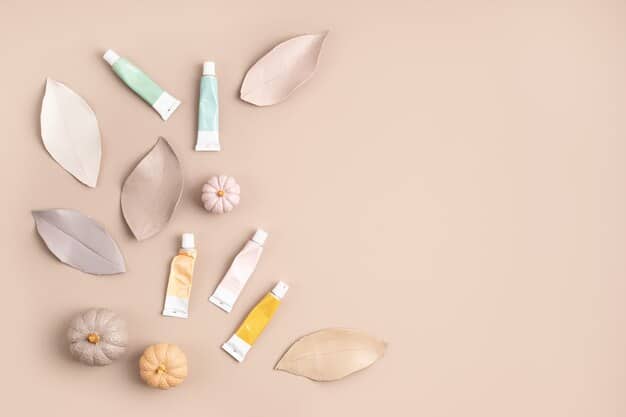
Frequently Asked Questions About Post-Workout Skincare
Post-workout breakouts often occur because sweat, oil, and bacteria readily mix on the skin’s surface, clogging pores and creating an ideal environment for acne-causing bacteria to thrive. Friction from clothing or equipment can further irritate skin, contributing to these breakouts, often known as “acne mechanica,” necessitating prompt cleansing and targeted care.
While not always feasible, showering or at least cleansing your face and body promptly after exercise is highly recommended. This immediate action helps remove sweat, dirt, and bacteria before they can settle into pores and cause breakouts. If a full shower isn’t an option, use gentle cleansing wipes as a temporary solution until you can properly wash.
For acne-prone skin, look for cleansers containing salicylic acid (BHA) to exfoliate and unclog pores, or benzoyl peroxide to kill acne-causing bacteria. For sensitive skin, opt for gentle, non-comedogenic, pH-balanced formulas that won’t strip your skin of natural oils and disrupt its protective barrier, minimizing irritation and dryness.
Sweat itself isn’t the primary cause of acne, but rather its interaction with other factors. When sweat mixes with dead skin cells, sebum, and bacteria on the skin surface, it creates a hospitable environment for acne-causing bacteria to multiply. This combination along with friction can lead to clogged pores and inflammation, manifesting as breakouts.
Yes, choosing the right workout attire is crucial for preventing body acne. Opt for loose-fitting, moisture-wicking fabrics like synthetic blends or bamboo, which draw sweat away from the skin. Avoid tight clothing and materials like cotton that absorb and trap moisture, as these can create a damp, friction-prone environment conducive to breakouts.
Conclusion
Maintaining clear, healthy skin doesn’t have to be a battle against your fitness routine. By understanding the dynamics of post-workout skin and implementing these four strategic steps – immediate cleansing, proper hydration and toning, targeted treatments, and smart protective measures – you can significantly reduce the likelihood of breakouts. This holistic approach ensures that your dedication to physical well-being also extends to your skin’s health, leaving you feeling confident and refreshed inside and out.
